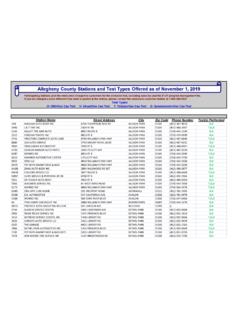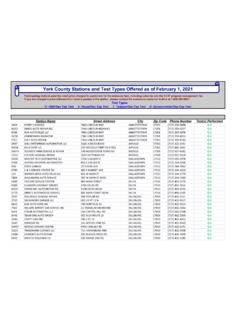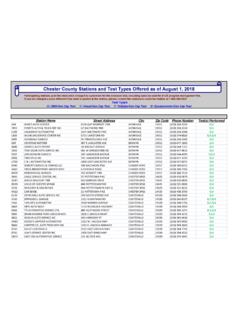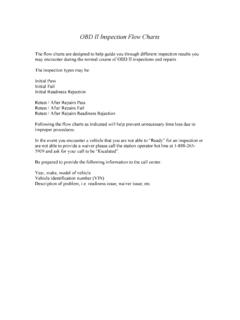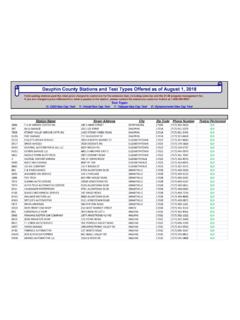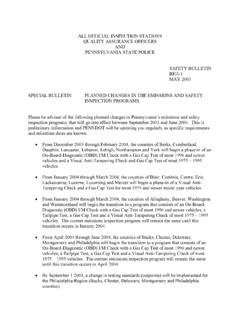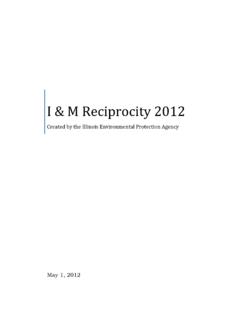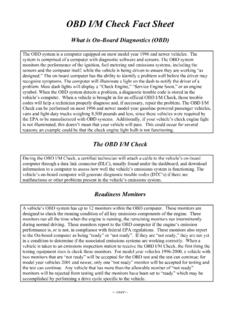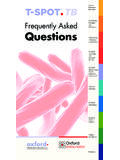Transcription of Frequently Asked Questions - Welcome to Drive …
1 1 11-03 S - Frequently Asked Questions - Emissions and Safety Inspection Program Changes BACKGROUND In 2002, Citizens For Pennsylvania s Future (PennFuture) and the Clean Air Council initiated two lawsuits over the Commonwealth s slow progress in implementing auto emissions inspection procedures mandated by the Environmental Protection Agency (EPA). In May, 2003, PENNDOT and DEP announced an agreement to settle these lawsuits over Pennsylvania s program for automobile emissions testing. The changes called for in this agreement bring the state s emissions testing program into compliance with federal air quality standards while having a minimal effect on most of the state s drivers.
2 The programs in the agreement rely heavily on the on-board diagnostic (OBD) systems present in cars manufactured since 1996. This technology allows a technician to attach a cable to a car s on-board computer and download information that helps them diagnose common engine problems that lead to increased pollution. Emissions inspections for subject vehicles will be required once a year in conjunction with the annual safety inspection. Emissions inspections can be done at any participating private garage or dealer that is certified to perform emissions inspections.
3 The fees for emissions and safety inspections will continue to be market driven. Competition permits customers to choose inspection sites based on price, service and convenience. TYPES OF EMISSIONS INSPECTIONS On-Board Diagnostics (OBD) Check What is On-Board Diagnostics (OBD)? OBD is an on-board system comprised of a computer with diagnostic software and sensors. The OBD system monitors the performance of the ignition, fuel metering and 2 emissions systems, including the sensors and the computer itself, while the vehicle is being driven to insure they are working as designed.
4 The on-board computer has the ability to identify a problem well before the driver may recognize symptoms. The computer will illuminate a light on the dash to notify the driver of a problem. Most dash lights will display a Check Engine, Service Engine Soon, or an engine symbol. When the OBD system detects a problem, a diagnostic trouble code is stored in the vehicle s computer. When a vehicle is brought in for an official OBD I/M Check, those trouble codes will help a technician properly diagnose and, if necessary, repair the problem. The OBD I/M Check can be performed on most 1996 and newer model-year gasoline-powered passenger vehicles, vans and light-duty trucks weighing 8,500 pounds and less, since these vehicles were required by the EPA to be manufactured with OBD systems.
5 How is an OBD I/M Check performed? A certified technician will attach a cable to the vehicle s on-board computer through a data link connector (DLC), usually found under the dashboard, and download information to a computer to access how well the vehicle s emissions system is functioning. The vehicle s on-board computer will generate diagnostic trouble codes (DTC s) if there are malfunctions or other problems present in the vehicle s emissions system. What if the data link connector (DLC) is not able to be located is blocked by auxiliary equipment or has been removed?
6 Within the first year of the program, if a DLC cannot be found or is inaccessible, the test will consist of a check to ensure the check engine light (located on the dashboard) is operating properly and is not continuously lit. After the first year of the program, the DLC will have to be accessible or replaced/repaired as necessary to perform the inspection. Tailpipe Tests What is a Tailpipe Test? A Tailpipe Test uses a tailpipe probe to collect a sample of the exhaust and an emissions analyzer to measure pollutants while the engine is idling. The Tailpipe Test can be performed on many gasoline-powered passenger vehicles, vans and light-duty trucks.
7 Inspection requirements are based on each vehicle s model year, with an allowance for normal wear. How is a Tailpipe Test performed? First, a certified technician will verify that the vehicle s engine is running at operating temperature. Then, the technician will insert a probe into the tailpipe to capture a sample of the engine s exhaust. After approximately 30-45 seconds, the analyzer will determine whether or not the vehicle is emitting excess pollutants based on the vehicle s model year. 3 What is a Tailpipe Test Utilizing a Dynamometer? A Tailpipe Test Utilizing a Dynamometer uses an emissions analyzer and a treadmill-like device, called a dynamometer, which puts a load on the engine to simulate driving conditions at 15 miles per hour.
8 The Tailpipe Test Utilizing a Dynamometer can be performed on many gasoline-powered passenger vehicles, vans and light-duty trucks. Inspection requirements are based on each vehicle s model year, with an allowance for normal wear. How is a Tailpipe Test Utilizing a Dynamometer performed? First, a certified technician will verify that the vehicle s engine is running at operating temperature. Then, the technician will place the vehicle s Drive wheels on the dynamometer rollers. The technician will then insert a probe into the tailpipe to capture a sample of the engine s exhaust.
9 After approximately 30-45 seconds, the analyzer will determine whether or not the vehicle is emitting excess pollutants based on the vehicle s model year. Why is a dynamometer used for some Tailpipe Tests? In the Philadelphia region, where air pollution is more severe, it is necessary to reduce harmful oxides of nitrogen (NOX). To do this, the vehicle s engine must be tested while under load. The treadmill-like device is the only method of applying a load to the vehicles Drive wheels to test for NOX. Gas Cap Test What is a Gas Cap Test? A Gas Cap Test is a functional check that tests whether harmful evaporative emissions (fumes) are escaping from a vehicle s gas tank into the atmosphere.
10 How is a Gas Cap Test performed? A certified technician will remove the gas cap and insert it into a device that will then apply pressure to the gas cap. The testing unit will verify that the gas cap holds pressure for a period of approximately 45 seconds and a determination will be made as to whether or not fumes are escaping. Visual Anti-Tampering Check What is a Visual Anti-Tampering Check? The Visual Anti-Tampering Check is a visual inspection for the presence of emission control components that were installed on a vehicle by the manufacturer. How is a Visual Anti-Tampering Check performed?

